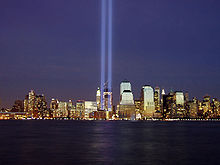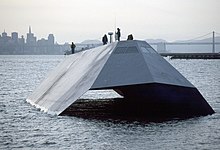
Reduction of radar cross section (RCS), visibility and noise is not unique to stealth ships; visual masking has been employed for over two centuries and RCS reduction traces back to American and Soviet ships of the Cold War. One common feature is the inward-sloping tumblehome hull design that significantly reduces the RCS.

Several surface vessels employ stealth technology, amongst them the Swedish Visby-class corvette, the Dutch Zeven Provinciën-class frigate, the Turkish MİLGEM corvette, the Norwegian Skjold-class patrol boat, the French La Fayette-class frigate, the Chinese Houbei-class missile boat and Type 054 frigate, the German MEKO ships Braunschweig-class corvettes and Sachsen-class frigates, the Indian Shivalik-class frigate, the Singaporean Formidable-class frigate, the British Type 45 destroyer, the U.S. Navy's Zumwalt-class destroyer, Finnish Hamina-class missile boats and Chilean Patrol Vessel PZM based on the German OPV80.
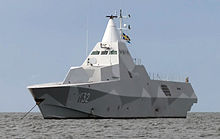 HMS Helsingborg, one of the Swedish Navy's Visby-class corvettes. | 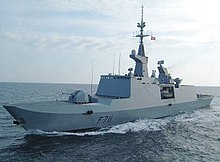 French frigate Surcouf of the La Fayette class | 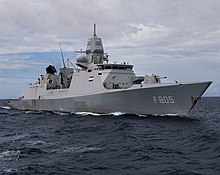 Dutch destroyer Evertsen of the Zeven Provinciën class |
Visby is designed to elude visual detection, radar detection, acoustic detection, and infrared detection. Its surface is constructed from a carbon fibre reinforced plastic. Avoidance of right angles in the design results in a smaller radar signature, reducing the ship's detection range.
Britain's Type 45 anti-air warfare destroyer has similarities to the Visby class, but is much more conventional, employing traditional steel instead of carbon fibre. Like Visby, its design reduces the use of right angles.
The currently developed U.S. Zumwalt-class destroyer — or DD(X) — is the US version of a stealth ship. Sea Shadow, which utilizes both tumblehome and SWATH features, was an early U.S. exploration of stealth ship technology. The Arleigh Burke-class destroyer also employs stealth technology without being a full stealth ship, similar to the German designs.
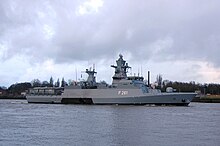 German Braunschweig-class corvette |  Artist's conception of the USS Zumwalt, the lead ship of the planned Zumwalt class of destroyer for the U.S. Navy |  Type 45 Royal Navy destroyer |
Ady Gil, operated by the Sea Shepherd Conservation Society, was painted with what the owners claimed to be radar-absorbent material. Thus, Ady Gil would have been a rare case of a non-military vessel employing stealth technology.
Shaping
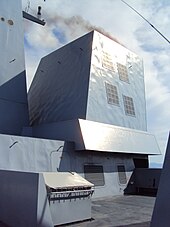
In designing a ship with reduced radar signature, the main concerns are radar beams originating near or slightly above the horizon (as seen from the ship) coming from distant patrol aircraft, other ships or sea-skimming anti-ship missiles with active radar seekers. Therefore, the shape of the ship avoids vertical surfaces, which would perfectly reflect any such beams directly back to the emitter. Retro-reflective right angles are eliminated to avoid causing the cat's eye effect. A stealthy ship shape can be achieved by constructing the hull and superstructure with a series of slightly protruding and retruding surfaces. This design was developed by several German shipyards, and is thus extensively applied on ships of the German Navy.
